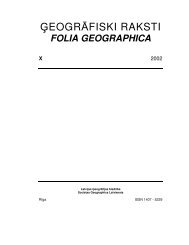eogrÄfiski raksti folia geographica xii - Ä¢eogrÄfijas un Zemes zinÄtņu ...
eogrÄfiski raksti folia geographica xii - Ä¢eogrÄfijas un Zemes zinÄtņu ...
eogrÄfiski raksti folia geographica xii - Ä¢eogrÄfijas un Zemes zinÄtņu ...
Create successful ePaper yourself
Turn your PDF publications into a flip-book with our unique Google optimized e-Paper software.
87<br />
LANDSCAPES AND CULTURE<br />
(4) wonders of the world and knowing oneself; (5) searching for home; (6) the poetics of house<br />
and home.<br />
As said before, the method was inductive with discoveries made in the writing of the<br />
manuscript. There was an overall plan for each chapter, but this was flexible. Chronology was<br />
less important than experiences and perceptions in particular landscapes and places. Fearing<br />
tangents and dissipation of thematic material, I imposed a strict discipline in this, even if that<br />
meant excluding a number of major events (such as the escape of our family from a Nazi labor<br />
camp in Szczecin in 1945 during a Russian bombing raid). I believe I thus I ensured that the<br />
book did not turn into a history or a memoir, but stayed firmly in geography. Each geographic<br />
theme that I pursued has a temporal dimension, however the overall structure is geographic.<br />
Renewing the torn connections with the Classical Era and the Renaissance<br />
In the history of ideas the Renaissance was a return to human life in the present, especially life<br />
of the individual human being, and the variegated philosophy of humanism was the result. That<br />
also meant a return to the Greek and Roman classics, for the thinkers and writers of that era<br />
established humanism as a distinct, if nebulous philosophy that addresses human problems in<br />
the proverbial “here and now.” During the Renaissance writings of a geographic nature were<br />
also humanistic, recording not only facts of explorations but being also “reflective and<br />
rhetorical” [Cosgrove 2003, 854]. In short, art and science were <strong>un</strong>ified in geographic writings.<br />
With the rise of modern geography that <strong>un</strong>ity was essentially torn apart. Alexander von<br />
Humboldt (1769-1859) was the last to practice such geography. Every effort was made to<br />
establish geography as a rigorous, scientific discipline. The life of the individual human being<br />
became of little interest to geographers. Geography lost its ties to the Renaissance. Its practice<br />
came to be firmly situated in a humanism known as scientific and technical.<br />
Obviously modern writers and artists never lost interest in the lives of human individual beings.<br />
Ties to the Renaissance and to the Classical World are implicit if not always self-evident. For<br />
many each human being is a distinct world. Homer’s Odyssey can still speak to a contemporary<br />
consciousness, as can Shakespeare’s King Lear and Hamlet, Benjamin Britten’s opera Peter<br />
Grimes, Orson Welles film Citizen Kane, the self-portraits of Pierre Bonnard. Marcel Proust’s<br />
In search of lost time is still regarded as perhaps the penultimate exploration of an individual’s<br />
life world [B<strong>un</strong>kse 2004, 4].<br />
Why do these works interest us? As I write in Geography and the art of life [B<strong>un</strong>kse 2004, 4],<br />
The lives depicted in …[the above] works interest us not only because they are works of artistic<br />
genius but also because they speak to us of <strong>un</strong>iversal human joy and pain and the mysteries of<br />
life at particular times and in particular places.<br />
Such traditions are largely absent from geography. But could it not be otherwise?<br />
References<br />
Bachelard, G. (1969). The poetics of space. Boston: Beacon Press.<br />
Blainey, G. (1968). The tyranny of distance: How distance shaped Australian history.<br />
Melbourne, London: MacMillan.<br />
Brown, R.H. (1943). Mirror for Americans: Likeness of the Eastern Seaboad (1810) New<br />
York: The American <strong>geographica</strong>l society.<br />
B<strong>un</strong>kše, E. V. (1990), “Saint Exupery’s geography lesson: Art and science in the creation and<br />
cultivation of landscape values. Annals of the association of American geographers, 80, 96-108.<br />
B<strong>un</strong>kše, E.V. (1998). Sirēnu balsis: ģeogrāfija kā cilvēcīga erudīcija. [Siren’s Voices:<br />
Geography as humane erudition] Rīga: Norden. In Latvian.<br />
B<strong>un</strong>kše, E.V. (2004). Geography and the art of life. Baltimore & London: The Johns Hopkins<br />
University Press.<br />
Buttimer, A. (1971). Society and milieu in the French geographic tradition. Chicago: Rand<br />
McNally and Company.

















